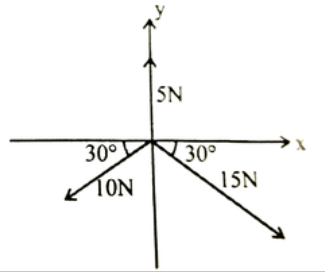The magnitudes of mutually perpendicular forces a,b and c are 2,10 and 11 respectively. Then the magnitude of its resultant is
12
15
9
none of these
The correct Answer is:B
To find the magnitude of the resultant of three mutually perpendicular forces a,b, and c with magnitudes 2, 10, and 11 respectively, we can follow these steps:
Step 1: Identify the Magnitudes
The magnitudes of the forces are given as:
- |a|=2
- |b|=10
- |c|=11
Step 2: Use the Formula for Resultant of Perpendicular Vectors
For three mutually perpendicular vectors, the magnitude of the resultant R can be calculated using the formula:
R=√|a|2+|b|2+|c|2
Step 3: Substitute the Values
Substituting the values of the magnitudes into the formula:
R=√22+102+112
Step 4: Calculate Each Square
Now, calculate the squares of each magnitude:
- 22=4
- 102=100
- 112=121
Step 5: Sum the Squares
Now, add these squared values together:
R=√4+100+121
R=√225
Step 6: Calculate the Square Root
Finally, calculate the square root of 225:
R=15
Conclusion
The magnitude of the resultant of the three mutually perpendicular forces is 15.
---
The magnitudes of the forces are given as:
- |a|=2
- |b|=10
- |c|=11
For three mutually perpendicular vectors, the magnitude of the resultant R can be calculated using the formula:
R=√|a|2+|b|2+|c|2
Substituting the values of the magnitudes into the formula:
R=√22+102+112
Now, calculate the squares of each magnitude:
- 22=4
- 102=100
- 112=121
Now, add these squared values together:
R=√4+100+121
R=√225
Finally, calculate the square root of 225:
R=15
The magnitude of the resultant of the three mutually perpendicular forces is 15.
Topper's Solved these Questions
- VECTOR ALGEBRABook:ARIHANT MATHS ENGLISHChapter:VECTOR ALGEBRAExercise:Exercise (More Than One Correct Option Type Questions)
Explore 7 Videos
- VECTOR ALGEBRABook:ARIHANT MATHS ENGLISHChapter:VECTOR ALGEBRAExercise:Exercise (Statement I And Ii Type Questions)
Explore 3 Videos
- VECTOR ALGEBRABook:ARIHANT MATHS ENGLISHChapter:VECTOR ALGEBRAExercise:VECTOR ALGEBRA EXERCISES 1: Single Option Correct Type Questions
Explore 1 Video
- TRIGONOMETRIC FUNCTIONS AND IDENTITIESBook:ARIHANT MATHS ENGLISHChapter:TRIGONOMETRIC FUNCTIONS AND IDENTITIESExercise:Exercise (Questions Asked In Previous 13 Years Exam)
Explore 19 Videos
Similar Questions
The maximum and minimum magnitudes of the resultant of two forces are 5 N and 5N respectively. Find the magnitude of resultant force when act orthogonally to each other.
View SolutionThe greater and least resultant of two forces are 9 N and 5 N respectively. If they are applied at 60°. The magnitude of the resultant is
View SolutionABC is an isosceles triangle right angled at A. forces of magnitude 2√2,5and6 act along BC, CA and AB respectively. The magnitude of their resultant force is
View SolutionFind the magnitude of the resultant of shown forces :-

View SolutionWhen two vectors a and b of magnitudes 'a' and 'b' respectively are added, the magnitude of resultant vector is always
View SolutionThe greatest & the least magnitude of the resultant of two forces of constant magnitudes are P & Q respectively. If the forces act at an angle 2α, then prove that the magnitude of their resultant is given by √P2cos2α+Q2sin2α.
View SolutionThe magnitude of x and y components of →A are 7 and 6 respectively . Also , the magnitudes of x and y components of →A+→B are 11 and 9 respectively . Calculate the magnitude of vector →B
View SolutionThe magnitude of vectors A, B and C are 3, 4 and 5 units respectively. If A+ B =C , the angle between A and B is
View SolutionFour forces are acting on a body as shown in figure. The magnitude of resultant of the forces is
View SolutionTwo vectors have magnitudes 3 unit and 4 unit respectively. What should be the angel between them if the magnitude of the resultant ils a. 1 unit, b. 5 unit and c. 7 unit.
View Solution

